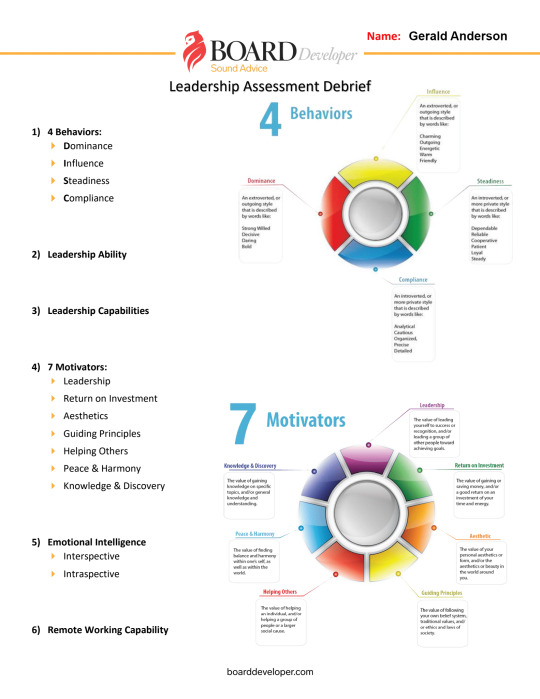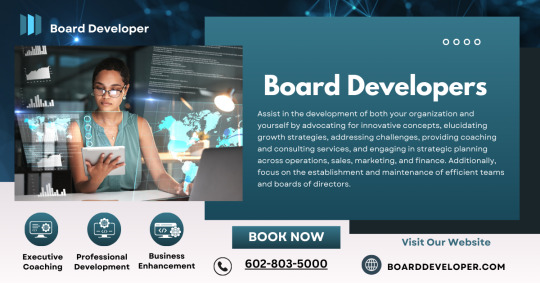Text

Board Developers contribute to the advancement of businesses and individuals by encouraging creative ideas, specifying growth targets, resolving issues, delivering coaching and consulting, and taking part in strategic planning in the areas of operations, sales, marketing, and finance.
#business enhancement#board engagement management#executive coaching jobs#professional development coaching#boarddeveloper#coaching for professional development#executive careers coaching#professionaldevelopment#sales coaching
0 notes
Text
Success in the Boardroom: Involvement That Generates Results
In today’s complex and high-velocity business environment, the success of an organisation is no longer the sole responsibility of its CEO or executive leadership team. Increasingly, sustainable success is a shared achievement — and the boardroom is a critical arena where that success is either enabled or hindered. The new benchmark for effective governance is not passive oversight, but active, strategic involvement that generates real results.
Top-performing boards are moving beyond quarterly meetings and rubber-stamping reports. They are evolving into high-impact leadership bodies that add value through insight, foresight, and purposeful engagement. When board involvement is thoughtfully structured and strategically aligned, it becomes a catalyst for growth, innovation, and accountability.

The Power of Purposeful Involvement
Boardroom success hinges on more than attendance and compliance. It’s about involvement with intention — showing up with clarity, commitment, and the courage to challenge, support, and collaborate.
Strategically involved boards:
Shape long-term vision and mission alignment
Contribute to risk intelligence and scenario planning
Offer diversity of thought during strategic pivots
Ensure leadership development and succession are in motion
Monitor performance with relevance, not rigidity
By connecting governance with strategy, they unlock untapped value and elevate the entire organisation’s performance trajectory.
Key Ingredients for Impactful Board Involvement
1. Clear Strategic Mandate
World-class boards don’t just ask, “What’s going on?” — they ask, “Where are we going, and how can we help get there?” Establishing a shared strategic mandate ensures that all board activity contributes to the broader organisational vision. This includes being aligned on key strategic themes such as growth, digital transformation, ESG, and stakeholder value creation.
2. Constructive Challenge and Support
Healthy boardrooms foster a culture of respectful tension — the kind that provokes new thinking without undermining leadership. Effective boards challenge assumptions, interrogate blind spots, and offer seasoned advice, acting as a safety net for bold decision-making.
3. Agile and Informed Decision-Making
Modern governance demands real-time insight, not post-mortem reviews. Boards that stay agile — through frequent touchpoints, access to real-time data, and streamlined committees — are better equipped to offer timely input and stay ahead of disruption.
4. Diversity That Drives Dialogue
A successful board isn’t just diverse in composition — it’s diverse in thinking, experience, and perspective. This enables robust dialogue, less groupthink, and decisions that reflect the complex ecosystems in which businesses operate.
How Strategic Board Involvement Drives Results
Companies with actively engaged boards tend to outperform in several areas:
Financial Resilience: Boards that focus on long-term value rather than short-term wins ensure that the organisation is built to withstand economic headwinds.
Innovation Acceleration: Directors who are plugged into emerging trends and industry shifts help leadership innovate with confidence.
Talent and Culture: Strong boards advocate for inclusive cultures, leadership development, and succession planning — securing the human capital engine of the business.
Stakeholder Trust: Transparent, ethical governance backed by engaged directors fosters trust among investors, regulators, employees, and customers.
When board members bring their full intellectual, emotional, and strategic capacities to the table, they become more than fiduciaries — they become co-architects of progress.

Conclusion: Elevating the Boardroom from Formality to Force
Success in the boardroom is not a product of status or tradition — it’s the outcome of intentional, informed, and integrated involvement. The most effective boards today don’t just monitor the organisation’s direction; they help shape it. They don’t merely protect value — they create it.
If we want better results, we must demand more from the boardroom: more engagement, more courage, more vision. When the board gets involved strategically and purposefully, the ripple effects are powerful — across performance, culture, innovation, and legacy.
In the modern organisation, boardroom involvement isn’t a formality. It’s a lever for extraordinary results.
#business enhancement#board engagement management#executive coaching jobs#executive-coaching#boarddeveloper#sales coaching#professionaldevelopment#executive careers coaching#coaching for professional development#professional development coaching
0 notes
Text

Board Developers facilitate both corporate and individual advancement by fostering innovative concepts, defining growth targets, tackling obstacles, providing coaching and consulting services, and engaging in strategic planning across operations, sales, marketing, and finance.
#business enhancement#executive coaching jobs#professional development coaching#executive careers coaching#boarddeveloper#professionaldevelopment#coaching for professional development#executive-coaching#board engagement management#sales coaching
0 notes
Text

Board Developers help your company and yourself grow by promoting new ideas, clarifying growth plans, problem solving, coaching, consulting, and strategic planning in operations, sales, marketing, and finance, as well as forming/maintaining effective teams and/or boards of directors.
#executive-coaching#boarddeveloper#ProfessionalDevelopment#Business Enhancement#Sales Coaching#Executive Careers Coaching
0 notes
Text

Board Developers assist your organization and yourself in growing by encouraging new ideas, clarifying growth plans, issue solving, coaching, consulting, and strategic planning in operations, sales, marketing, and finance, as well as forming/maintaining successful teams and/or boards of directors.
#https://boarddeveloper.com/#executive-coaching#boarddeveloper#ProfessionalDevelopment#Business Enhancement#Sales Coaching#Executive Careers Coaching
0 notes
Text

Board Developers facilitate growth for both your organization and yourself by fostering innovative ideas, elucidating growth strategies, addressing challenges, providing coaching and consulting, and engaging in strategic planning across operations, sales, marketing, and finance. They also play a crucial role in establishing and sustaining effective teams and boards of directors.
#professional development coaching#executive coaching jobs#business enhancement#board engagement management
0 notes
Text

#Professional Development Coaching#coaching for leadership development#Career Coaching for Executives#coaching for professional development#coaching leadership development#leadership coaching companies
0 notes
Text
Public Speaking and Presentation Sales Coaching: Mastering the Art of Persuasion.
Public speaking and presentations are key parts of the sales process. Whether pitching new clients, speaking at industry events, or leading internal meetings, a salesperson's ability to communicate effectively and convincingly may have a huge impact on their performance. Sales coaching for public speaking and presentations prepares professionals to deliver captivating messages, engage audiences, and achieve desired results.

The Importance of Public Speaking for Sales
Public speaking is an effective technique in the sales professional's toolkit. It enables direct sharing of ideas, the construction of trustworthiness, and the development of emotional ties with the audience. Salespeople who thrive at public speaking can better articulate their value propositions, resolve objections, and complete agreements. Sales coaching in this area is critical for helping professionals overcome typical worries, improve their delivery, and present with confidence.
Building Confidence via Practice
One of the key purposes of sales coaching for public speaking is to instill confidence. Many salespeople become anxious while speaking in front of others, which might impair their effectiveness. Coaching helps people build the confidence they need to speak with authority and poise by providing frequent practice and critical criticism. Visualization, breathing exercises, and positive self-talk are common techniques used in coaching sessions to assist professionals overcome uneasiness and portray confidence.
Creating Effective Presentations
An excellent presentation is well-organized and easy to understand. Sales coaching emphasizes the need to structure material logically, with a clear beginning, middle, and finish. This format keeps the audience interested and ensures that the main points are communicated successfully.
Engaging the audience
Engaging the audience is essential for a good presentation. Sales coaching focuses on tactics that keep the audience interested and engaged. To sustain attention, make eye contact, use good body language, and alter tone and tempo. Coaches can assist sales professionals in developing tactics for connecting with the audience, such as asking questions, promoting involvement, and responding to concerns in real-time. Engaging presentations are more remembered and compelling, which results in greater outcomes.
Handling objections and questions.
Handling objections and inquiries with confidence is an important part of sales presentations. Sales coaching teaches professionals how to anticipate and respond to unexpected objections or hard questions that may occur during presentations. This involves rehearsing replies, remaining calm under pressure, and using objections to strengthen the value argument. Effective addressing of objections indicates knowledge and fosters trust in the audience.

Use Visual Aids Effectively
Visual aids are an effective tool for presentations, but they must be utilized intelligently. Sales coaching teaches professionals how to build and deploy visual aids that enhance rather than overpower their message. This includes creating clear, short, and visually attractive presentations, as well as incorporating charts, graphs, and photos to illustrate crucial ideas. Coaches also highlight the need to avoid depending too much on visual aids, so that the speaker remains the major focus of the presentation.
Conclusion
Sales coaching for public speaking and presentations is vital for professionals who want to improve their communication skills and sales success. Sales professionals may increase their confidence, structure efficient presentations, engage their audience, handle objections, and effectively use visual aids.
0 notes
Text

boarddeveloper
0 notes
Text

0 notes
Text

0 notes
Text
youtube
0 notes
Text
#executive coaching firms#professional development coaching#career coaching for executives#coaching for professional development
0 notes
Text
Mastering the Balance: Navigating Instant and Delayed Gratification
In an age of instant connectedness and lightning-fast responses, the argument between instant satisfaction and delayed gratification has never been more pressing.
These opposing approaches to decision-making can have a significant impact on our lives, influencing our financial habits, job paths, and overall well-being. Understanding the relationship between these two notions is critical for making educated decisions that are consistent with our long-term goals and desires.

Instant gratification, defined as the drive for immediate rewards or pleasures, has become synonymous with modern life. With the stroke of a mouse, we can order items online, binge-watch our favorite shows, or indulge in sumptuous delights delivered right to our homes. While these rapid pleasures provide immediate delight, they frequently come with
Instant gratification, defined as the drive for immediate rewards or pleasures, has become synonymous with modern life. With the stroke of a mouse, we can order items online, binge-watch our favorite shows, or indulge in sumptuous delights delivered right to our homes.
While these quick pleasures provide temporary joy, they frequently have long-term implications, such as overspending, procrastinating, or disregarding important obligations. On the other hand, delayed gratification entails foregoing current pleasure in return for higher rewards in the future. This strategy necessitates patience, discipline, and a willingness to put up with short-term discomfort in exchange for long-term gains.
Whether it's investing in education, saving for retirement, or developing meaningful relationships, delayed gratification allows people to prioritize their long-term well-being over ephemeral cravings. The conflict between these two paradigms is visible in many areas of our lives, including personal wealth, job growth, and health and wellness.
Consider the person divided between buying a luxury item on impulse and saving the money for a down payment on a property. While fast gratification may bring immediate joy, it can also disrupt progress toward more important financial goals, such as homeownership or retirement savings. Similarly, in terms of job advancement, the decision between instant and delayed gratification might influence one's professional path. Choosing rapid gratification may entail seeking immediate rewards or promotions without considering the long-term effects on job satisfaction or personal development.
In contrast, accepting delayed gratification may require spending time and effort in skill development.
Furthermore, the effects of rapid and delayed gratification extend to our physical and mental health.
Choosing fast gratification, such as eating unhealthy foods or engaging in sedentary habits, can provide immediate pleasure while also contributing to long-term health difficulties such as obesity, diabetes, and cardiovascular disease.
Prioritizing delayed gratification by adopting healthy lifestyle habits like regular exercise and balanced eating, on the other hand, can result in better health outcomes and a higher quality of life over time.
Psychological research has demonstrated the importance of delayed gratification in predicting success and resilience in a variety of life areas. The seminal Stanford marshmallow experiment found that children who could delay gratification by refusing to eat a marshmallow right away in exchange for a greater reward later had higher levels of self-control, academic achievement, and overall well-being as adults.

Finding a balance between rapid gratification and delayed gratification is critical for personal harmony and fulfillment.
While rapid gratification provides immediate rewards and joys, it frequently involves trade-offs that may jeopardize long-term goals and aspirations.
Deferred gratification, on the other hand, demands patience, perseverance, and a firm commitment to future accomplishment, but it results in greater benefits and long-term happiness.
Finally, the interplay between rapid satisfaction and delayed gratification emphasizes the basic distinction between short-term indulgence and long-term fulfillment. Understanding the ramifications of each method and making intentional decisions that prioritize our long-term well-being will allow us to negotiate life's challenges with clarity, purpose, and resilience. Finally, mastering the balance between instant satisfaction and delayed gratification is critical to realizing our full potential and leading a meaningful and rewarding life.
0 notes
Text
Organizational Design and Structure for Effective Development
In the rich tapestry of organizational success, design, and structure are the underlying threads that connect the fabric of effectiveness and progress. These features are more than just defining responsibilities and reporting lines; they also aim to foster growth, creativity, and adaptation.
Let's look at the major ideas and techniques that guide organizational design and structure for effective development.

Organizational design is essentially a blueprint outlining how various components of an organization work together to achieve its goals. It entails establishing roles, responsibilities, processes, and communication channels in accordance with the organization's mission and objectives.
Effective design ensures clarity and consistency, allowing employees to understand their tasks in the greater context and how they contribute to corporate success.
Flexibility is a key organizational design principle for effective development. In today's quickly changing business market, businesses must be agile and flexible in order to embrace opportunities and handle problems.
Flexible arrangements, such as matrix organizations or cross-functional teams, facilitate rapid decision-making and cross-departmental communication. They enable employees to respond swiftly to changing market conditions, encouraging innovation and creativity. Furthermore, scalability is critical in organizational design. As businesses expand and adapt, their structures must be able to handle greater complexity without becoming cumbersome.
Scalable designs allow for seamless expansion, whether via organic growth or strategic acquisitions. Modular structures, for example, enable organizations to add or remove components as needed, maintaining agility and efficiency even as they grow.
Transparency and accountability are important issues in organizational design. Clear channels of communication and decision-making help to reduce ambiguity and build trust among personnel. Furthermore, performance management and feedback methods ensure that individuals and teams are held accountable for how they contribute to organizational goals.
This accountability promotes ongoing improvement and development, hence increasing total organizational effectiveness.
In addition to formal structure, organizational design should consider informal networks and interactions within the business. Social networks facilitate knowledge sharing, collaboration, and creativity. Leaders should foster an environment of openness and inclusivity, fostering informal contacts and linkages throughout the organization.
Organizations can use informal networks to tap into their workforce's collective intelligence and drive meaningful development.

Furthermore, organizational design should reflect the organization's culture and ideals. A strong culture that promotes innovation, collaboration, and continual learning can help the organizational structure function more effectively. Conversely, a mismatch between design and culture can cause friction and inefficiency. Leaders must ensure that the design reflects and promotes the desired culture, fostering an environment in which people feel empowered to put out their best efforts. Finally, organizational design and structure are critical components of effective development inside an organization. Organizations may support innovation, collaboration, and adaptability by prioritizing flexibility, scalability, transparency, accountability, and cultural alignment. Investing in thoughtful and intentional organizational design creates the framework for long-term development, allowing firms to survive in a constantly shifting commercial context.
0 notes
Text
0 notes
Text
1 note
·
View note